I am trying to save patches from OpenSubdiv subdivision using Open Cascade for one of my app that I am trying to build for subdivision surfaces. This is pretty similar to the thread - https://groups.google.com/g/opensubdiv/c/ujdolv75a4Q/m/djyq6xIqAAAJ
But I am not quite getting the result and I am not sure what I am missing. The overall shape of the output looks correct but surfaces are protruding into each other and they are not "smooth" at boundaries. So it looks like I am not able to query the patches right or something is wrong in converting the patches into the "Geom_BezierSurface" from Open Cascade. If you could just point me where I could start looking, that would be really helpful. I have spent some time on this but not getting anywhere.
Here is what my output looks like right now with 160 faces created.
If I just render first two faces from the output, they look like this
And here is my code
#include "Geom_BezierSurface.hxx"
#include <opensubdiv/far/topologyDescriptor.h>
#include <opensubdiv/far/primvarRefiner.h>
#include <opensubdiv/far/patchTableFactory.h>
#include <opensubdiv/far/patchMap.h>
#include <opensubdiv/far/ptexIndices.h>
#include <cassert>
#include <cstdio>
#include <cstring>
#include <cfloat>
using namespace OpenSubdiv;
typedef double Real;
static int const g_nverts = 5;
static double const g_verts[24] = { 0.0f, 0.0f, 20.0f,
0.0f, -20.0f, 0.0f,
20.0f, 0.0f, 0.0f,
0.0f, 20.0f, 0.0f,
-20.0f, 0.0f, 0.0f, };
static int const g_vertsperface[5] = { 3, 3, 3, 3, 4 };
static int const g_nfaces = 5;
static int const g_faceverts[16] = { 0, 1, 2,
0, 2, 3,
0, 3, 4,
0, 4, 1,
4, 3, 2, 1 };
static int const g_ncreases = 4;
static int const g_creaseverts[8] = { 4, 3, 3, 2, 2, 1, 1, 4 };
static float const g_creaseweights[4] = { 3.0f, 3.0f, 3.0f, 3.0f };
// Creates a Far::TopologyRefiner from the pyramid shape above
static Far::TopologyRefiner* createTopologyRefiner();
static Far::TopologyRefiner* createTopologyRefiner()
{
typedef Far::TopologyDescriptor Descriptor;
Sdc::SchemeType type = OpenSubdiv::Sdc::SCHEME_CATMARK;
Sdc::Options options;
options.SetVtxBoundaryInterpolation(Sdc::Options::VTX_BOUNDARY_EDGE_ONLY);
Descriptor desc;
desc.numVertices = g_nverts;
desc.numFaces = g_nfaces;
desc.numVertsPerFace = g_vertsperface;
desc.vertIndicesPerFace = g_faceverts;
desc.numCreases = g_ncreases;
desc.creaseVertexIndexPairs = g_creaseverts;
desc.creaseWeights = g_creaseweights;
// Instantiate a FarTopologyRefiner from the descriptor.
Far::TopologyRefiner* refiner =
Far::TopologyRefinerFactory<Descriptor>::Create(desc,
Far::TopologyRefinerFactory<Descriptor>::Options(type, options));
return refiner;
}
//------------------------------------------------------------------------------
// Vertex container implementation.
//
struct Vertex {
// Minimal required interface ----------------------
Vertex() { }
void Clear(void* = 0) {
point[0] = point[1] = point[2] = 0.0f;
}
void AddWithWeight(Vertex const& src, Real weight) {
point[0] += weight * src.point[0];
point[1] += weight * src.point[1];
point[2] += weight * src.point[2];
}
Real point[3];
};
void CModelingDoc::OnFace()
{
// Generate a FarTopologyRefiner (see far_tutorial_0 for details).
Far::TopologyRefiner* refiner = createTopologyRefiner();
// Adaptively refine the topology with an isolation level capped at 3
// because the sharpest crease in the shape is 3.0f (in g_creaseweights[])
int maxIsolation = 3;
refiner->RefineAdaptive(
Far::TopologyRefiner::AdaptiveOptions(maxIsolation));
// Generate a set of Far::PatchTable that we will use to evaluate the
// surface limit
Far::PatchTableFactory::Options patchOptions;
patchOptions.endCapType =
Far::PatchTableFactory::Options::ENDCAP_GREGORY_BASIS;
Far::PatchTable const* patchTable =
Far::PatchTableFactory::Create(*refiner, patchOptions);
// Compute the total number of points we need to evaluate patchtable.
// we use local points around extraordinary features.
int nRefinerVertices = refiner->GetNumVerticesTotal();
int nLocalPoints = patchTable->GetNumLocalPoints();
// Create a buffer to hold the position of the refined verts and
// local points, then copy the coarse positions at the beginning.
std::vector<Vertex> verts(nRefinerVertices + nLocalPoints);
memcpy(&verts[0], g_verts, g_nverts * 3 * sizeof(double));
// Adaptive refinement may result in fewer levels than maxIsolation.
int nRefinedLevels = refiner->GetNumLevels();
// Interpolate vertex primvar data : they are the control vertices
// of the limit patches (see far_tutorial_0 for details)
Vertex* src = &verts[0];
for (int level = 1; level < nRefinedLevels; ++level)
{
Vertex* dst = src + refiner->GetLevel(level - 1).GetNumVertices();
Far::PrimvarRefiner(*refiner).Interpolate(level, src, dst);
src = dst;
}
// Evaluate local points from interpolated vertex primvars.
patchTable->ComputeLocalPointValues(&verts[0], &verts[nRefinerVertices]);
std::vector<TopoDS_Face> mySurfaces;
// Loop through each patch and save out 4x4 vertices each
int na = patchTable->GetNumPatchArrays();
bool error;
for (int i = 0; i < na; i++)
{
Far::PatchDescriptor pd = patchTable->GetPatchArrayDescriptor(i);
if (pd == 6) // Type::REGULAR
{
Far::ConstIndexArray arraycvs = patchTable->GetPatchArrayVertices(i);
int np = patchTable->GetNumPatches(i);
for (int patch = 0; patch < np; patch++)
{
Far::ConstIndexArray cvs = patchTable->GetPatchVertices(i, patch);
int cvCount = cvs.size();
TColgp_Array2OfPnt surfVerts(1, 4, 1, 4);
for (int cv = 0; cv < cvCount; cv++)
{
int division = (int)((cv + 1) / 4);
int remainder = (cv + 1) % 4;
int firstIndex = remainder == 0 ? division : division + 1;
int secondIndex = remainder == 0 ? 4 : remainder;
surfVerts.SetValue(firstIndex, secondIndex, gp_Pnt(verts[cvs[cv]].point[0], verts[cvs[cv]].point[1], verts[cvs[cv]].point[2]));
}
Handle(Geom_BezierSurface) BZ1 =
new Geom_BezierSurface(surfVerts);
TopoDS_Face newFace = BRepBuilderAPI_MakeFace(BZ1, Precision::Confusion());
mySurfaces.push_back(newFace);
}
}
}
for (int i = 0; i < mySurfaces.size(); i++)
{
Quantity_NameOfColor myColor = static_cast<Quantity_NameOfColor>((i % 505) + 1);
Handle(AIS_Shape) myFace = new AIS_Shape(mySurfaces[i]);
myAISContext->SetColor(myFace, myColor, Standard_False);
myAISContext->SetMaterial(myFace, Graphic3d_NOM_PLASTIC, Standard_False);
myAISContext->Display(myFace, Standard_False);
}
}

